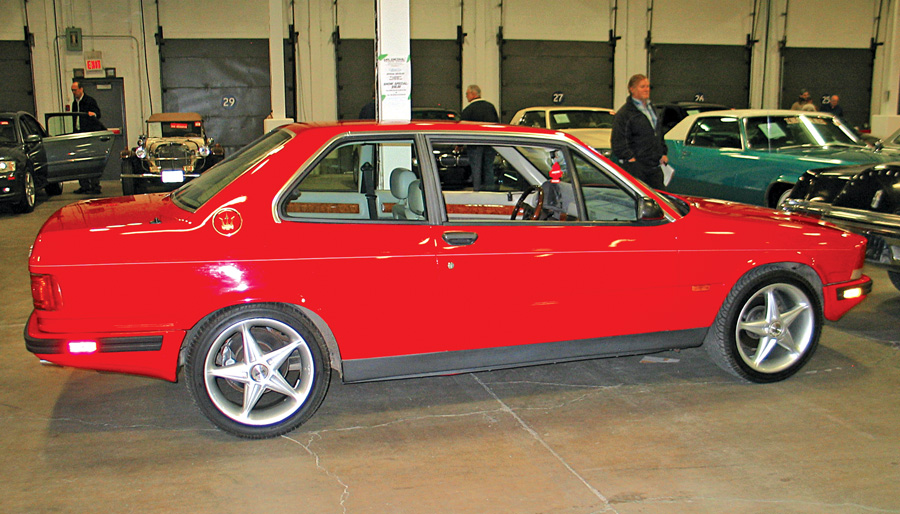
The year was 1990, and the venue was Laguna Seca raceway. I was there to get some open track time in an MGB. My run group that day included a deep crimson Maserati Biturbo, and I spent several hours studying every detail of the taillights and rear end.
That happened because passing wasn’t allowed in the corners and the damn slug had just barely enough power to outpull a stock MG on the straights.
That experience sums up the essence of the Maserati Biturbo. This car should have been much better than it actually was.
Biturbo 101
The Maserati Biturbo is a compact grand-touring car built on a unibody chassis. Available body styles include a 2-door coupe, 4-door sedan, and a rather fetching 2-door Spyder convertible. If you don’t look too closely, you might mistake a Biturbo coupe or sedan for a late-’70s Alfetta sedan with a different grille.
Power came from a V6 engine — the first ever to be mass-produced with twin turbos and three valves per cylinder. Italian-market cars got a 2.0-liter version for tax purposes. A few of those were imported to the U.S., but most American imports were 2.5 or 2.8 liters with 185 to 225 horsepower. The 2.5-liter engines were carbureted at first and then fuel-injected. All 2.8s were fuel-injected.
Engine power is passed to the rear wheels through a 5-speed manual gearbox or a 3-speed automatic. A limited-slip differential was standard on all models. Between 1984 and 1990, about 5,000 Maserati Biturbos of all body styles were imported to the U.S., mostly biased towards the early years.
It’s not really that bad, is it?
The Biturbo has suffered from a horrible reputation. There’s no dancing around that. Pulitzer Prize-winning automotive journalist Dan Neil ranked the Biturbo 28th on his list of the 50 worst cars of all time. Even so, taken in context of its era, was the Biturbo really so bad?
A fair answer would be, no, it’s not really that bad. A 2.8-liter Biturbo coupe can hit 60 mph in about 6–7 seconds, which is roughly the same as a contemporary Ferrari 308. The Biturbo I tailed around Laguna Seca should have left my poor little MG far behind, but there’s no knowing who that driver might have been.
Inside, the Biturbo came with nice leather and Alcantara upholstery — even if the seats do look a lot like Barcaloungers. It’s also not necessarily an ugly car. If you get the Spyder, the Biturbo looks about as good as a BMW 3 Series of the same era.
Twin turbos, twin problems
Two of the main problems with the Biturbo are the turbos themselves.
During the 1980s, few people ran synthetic motor oils. The oiling system both cools and lubricates the turbo bearings. Natural motor oils tend to burn and clog the passages, leading to expensive tragedy. Furthermore, fuel-injection systems of the era were notorious for vacuum leaks.
The Biturbo was subject to all of these issues, but it was never sexy enough to earn forgiveness.
Beyond the mechanical limitations of the era, Maserati was in deep financial trouble at this time — and was grasping for a success to stay afloat. A $26,874 sport coupe seemed like a good idea in 1984, but it wasn’t enough. By 1986, most Biturbos were priced around $30,000, and by 1989 they were up to $52,975. Yikes!
Cheap to buy
The SCM Pocket Price Guide rates the Biturbo as Investment Grade F. To quote the grading rubric, that means “Cars with few if any redeeming characteristics, that are consequently hopeless in nearly every way.” That’s harsh, man.
However, every dark cloud has a silver lining, and the good news is that you can get into a vintage (if not classic) Maserati pretty darn cheap. But first you have to get past the dreamers and the charlatans. There are plenty of Biturbos offered for prices in the $20,000–$30,000 range. It doesn’t matter how nicely the car has been kept — just don’t be the greater fool this time. The price guide estimates the Biturbo at $9,000–$11,000, and that’s generous.
Auction sales have been few and far between because a Biturbo is not a car one sells at auction.
At press time, there were two Biturbos on Hemmings, three at Cars.com, and 26 European models on Classic Trader. Those included the $30,000 offerings. A sweep of Craigslist nationwide found a few including a “mechanic’s special” at $1,000 and a very nice Spyder for $5,900.
Bring a Trailer has sold several in the $5,000 range. That’s more like it.
If you buy a well-kept Biturbo for about $5,000, especially a Spyder, you’ll get a quick, fun piece of history. It’s virtually guaranteed that no one else will show up with one at Cars & Coffee. Just do me one favor: If you see an MGB crowding your rear-view mirror, wave him around, okay? ♦